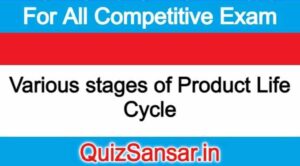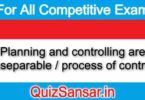
Various stages of Product Life Cycle
Product Life Cycle
Product life cycle is the historical study of (sales of) the product. It includes when it was introduced; when it was getting rapid acceptance; when it was on the peak of its position; when it started falling from the peak; and when it disappeared. Product passes through certain stages during its life span.
In fact, no product is capable to satisfy needs and wants of consumers for an unlimited period of time. As such, its sales and profits are subject to differ over time. The life of product can be determined by its capacity to meet market expectations. It lasts or exists as long as it satisfies its users.
The concept that studies the life span of product in relation to the demand is popularly known as product life cycle. We use ‘PLC’ as an abbreviation of Product Life Cycle. The concept PLC is important in marketing theory and practice. It is interesting to note that we can study the PLC only when product completes its entire life.
No doubt, we can detect particular stage product life cycle on the basis of sales and profits. Product life cycle should be studied with reference to the broad picture of demand-technology life cycle. It provides insight into the competitive dynamics. It is a readymade or expert prescription regarding what a marketing manager should do in different stages of the PLC. However, he concept may be misleading if it is not carefully understood and followed.
Typically, it passes through four stages as listed below:
1. Introduction: The product is introduced in the market.
2. Growth: The product is getting rapid acceptance and sales rise at the increasing rate.
3. Maturity (including Saturation) : Sales rise, but at the decreasing rate. Saturation is marked with stable sales.
4. Decline: It is the stage when sales start falling.
Assumptions: “S” shape curve is an ideal state, and is hardly possible.
Such diagram – stages, sales curve, and profit curve- is possible only if following assumptions are fulfilled:
1. Product completes its entire life cycle. It passes through all four stages of its life.
2. Duration of each of the stages is equal or
3. There is no reintroduction of product or fixed.
4. Product passes through stages in chronological order, that is, one, two, three and likewise. There is no bypassing or overlapping of any of the stages.
Stages of Product Life Cycle: Product life cycle comprises of four steps/stages. Each stage of product life cycle can be characterized in terms of at least four aspects-sales volume, amount of profits, level of promotional efforts and expenses, and degree of competition. Each stage demands the unique marketing strategy. Let us briefly describe each of the stages of the PLC.
1. Introduction Stage: Introduction stage starts when a new product is, for the very first time, made available for purchase. Consumers are not aware of product, or they may not have general opinion and experience regarding product. Moreover, a new product has to face the existing products. So, the sales remain limited.
In the very initial stage, there is loss or negligible profit. During this period, the direct competition is almost absent. Company has not mastered production and selling problems. Price is normally high to recover/offset costs of development, production, and marketing with minimum sales. So, sales rise at gradually.
2. Growth Stage: This is the stage of a rapid market acceptance. Due to increased awareness, the product gets positive response from market. This stage is marked by a rapid climb in sales. Sales rise at the increasing rate Profits follow the sales. Seller shifts his promotional attempts from “try-my brand” to “buy-my-brand.”
Company tries to develop effective distribution network. Here, the most of production and marketing problems are mastered. Due to rise in profits, competitors are attracted. At a right time, price may be reduced to attract the price-sensitive buyers.
Company continues, even increases, its selling and promotional efforts to educate and convince the market and meet competition. At the end of growth stage, sales start increasing at decelerated rate, consequently, profits starts to decline.
3. Maturity Stage: This stage is marked with slow down of sales growth. Sales continue to rise but at decreasing rate. Competitors have entered the market and existing products face severe competition. Sales curve is pushed downward. It is just like an inverse “U”. During this stage, for certain period of time, sales remain stable. This level is called the Saturation. Profits also decline. Normally, this stage lasts longer and marketers face formidable challenges.
The stages may be divided into three phases:
i. Growth Maturity: Sales-growth rate starts to decline.
ii. Stable Maturity: Sales remain stable (i.c., saturation stage).
iii. Decline Maturity: Sales now start to decline. Marginal producers are forced to drop out the products. Those who operate formulate various strategies to extend the stage. Market, products, and marketing programme are to be modified to sustain the stage.
4. Decline Stage: This is the last stage of product life cycle. Here, sales starts declining rapidly. Profits also start erasing. There is a minimum profit or even a little loss. Advertising and selling expenses are reduced to realize some profits. This stage is faced by only those who survived in maturity stage.
Most products obsolete as new products enter the market. All products have to face the stage earlier or later. New products start their own life cycle and replace old ones. A number of competitors withdraw from the market. Those who remain in the market prefer to drop smaller segments, make minor changes in products, and continue selling the products in profitable segments and channels.
Here, logic has its own role. Management continues with the same product with expectation that sales improve when economy improves: marketing strategy is revised expecting that competitors will leave the market; or product is improved to attract new market segments.
However, unless a strong reason exists, it is costly and risky to continue with the same products. Later on it is difficult of manage selling and promotional efforts. Marketer must check every possibility before dropping the product completely.






